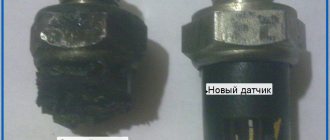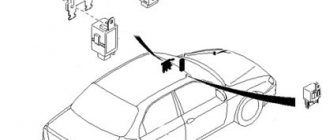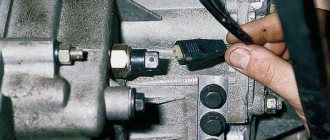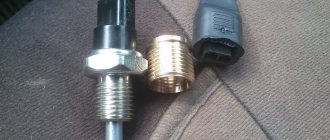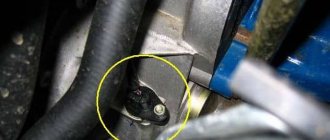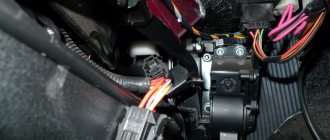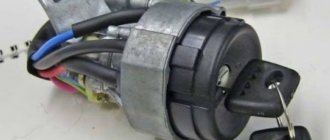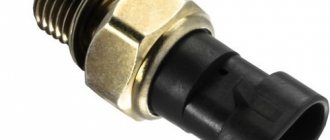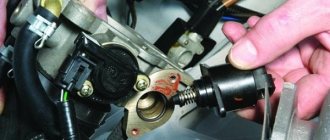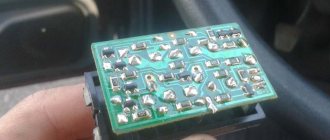VAZ speed sensor pinout and DS connection diagram
The speed sensor is an element of the vehicle's electronic control system. It depends on its readings how much fuel will be supplied, how much air will bypass the throttle valve when idling, and what the speedometer readings will be.
The speed sensor of a VAZ car is based on the use of the Hall effect, that is, a stream of pulses is transmitted from the device to the car's ECU, the frequency of which is proportional to the speed of the car. Auto electronics, analyzing incoming data, selects the required idle speed and sends a signal to a device that regulates the engine idle speed, which optimizes the composition of the air-droplet mixture entering the combustion chamber, bypassing the throttle valve.
During a distance of one kilometer, the speed sensor transmits over 6000 pulses to the ECU. Based on the parameters of the time analysis of inter-pulse signals, the on-board computer transmits data to the dashboard, thereby determining the speedometer readings.
As in many other cars, the VAZ speed sensor is located in the upper part of the gearbox housing, not far from the engine oil level dipstick. You can get to it from two sides: from above, by opening the hood and disconnecting the adsorber, and from below, using the inspection hole for convenience.
Speed sensor (DS) of injection engines of VAZ 21083, 21093, 21099 cars
The speed sensor of injection vehicles VAZ 21083, 21093, 21099 is an element of the electronic engine control system.
Purpose of the speed sensor
The speed sensor is designed to determine the speed of the vehicle by the ECM control unit (controller).
Speed sensor device
The speed sensor is an electromagnet installed on the output shaft of the speedometer drive in the vehicle's gearbox. The wiring harness block is attached to the top of it. The DS has a block with three terminals: current, pulse and ground. A multi-pole magnet is installed on the internal axis of the sensor, connected to the speedometer drive, and there is a master disk. The internal axis of the sensor rotates together with the speedometer drive.
Pinout DS 2109, 2110, 2112, 2114, 2115
If you understand how to connect the speed sensor, then there is the following pinout that you should follow. At the same time, it is important to understand the essence of the operation of the DS to study the circuit diagram of the sensor, which is attached to this article.
The factory speed sensor of VAZ cars is manufactured with some differences in connections to the block connector. The square-shaped connector is used in Bosh electronics systems. The circle-shaped connector is used in electronic systems such as January 4 and GM.
When connecting a sensor, you should choose devices with contact group digitization such as “-”, “A”, “+” (internal designation on the block contacts) instead of digital designations such as “1”, “2”, “3”. In addition, preference should be given to devices with a metal-type rod, since plastic rods are very short-lived.
Speedometer drive: types and differences
A speedometer is an important element in cars, as well as several other vehicles, as it is necessary to monitor speed in order not to violate traffic rules. But this is not the last function of this device.
All possible speedometers have a high-speed magnetic unit; due to the rotation of the magnets, a flow is formed, it moves through the coil, thereby facilitating the induction of eddy currents. They thereby begin to create more magnetic fields. They interact with each other, the needle of the device moves along the frequency scale, with the help of this the magnet rotates.
All speedometers are divided into three categories.
- Mechanical speedometers.
- Electromechanical speedometers.
- Electronic speedometers.
Mechanical speedometers. In this type of speedometer, the process of speed measurement and indication occurs thanks to a mechanical device. A gear is used as sensors, which is connected to the secondary shaft of the gearbox; this is the speed unit with an arrow indicator and the drum counter. Previously, speedometers were used in the form of a drum and tape. But they stopped using them quite a long time ago.
Electromechanical speedometers. In these devices, speed is measured using various electronic or electromechanical sensors that are connected to the gearbox. The speed is indicated by a milliammeter or the speed unit of a mechanical speedometer, and the distance is indicated by a counting drum, which drives a stepper motor.
We recommend:
How to change gears correctly on a gearbox
Electronic speedometers. This is a development of new electromechanical speedometers; the main difference is the replacement of the odometer - in an electronic device it is completely digital.
How to check the VAZ speed sensor
A failed speedometer sensor in a VAZ car is easily determined - in this case, the speedometer stops working, and it may also show some signs of life, but display incorrect information.
Using a tube, pliers or other available tools, rotate the sensor axis. In this case, you should see the voltmeter readings changing: the higher the speed, the higher the voltage (from 0.5 to 10 V). If this does not happen, the sensor requires replacement.
How to find out if our device is faulty
We may not always notice problems right away. This can turn into a huge problem - from a fine for speeding to road accidents and accidents.
Let's look at the main symptoms of a malfunction:
- It seems to you that the speedometer does not display the speed of your car correctly.
- Faulty idle.
- Lately you have been experiencing increased gas mileage.
- You can hear from the sound of the engine that it is not working at full power.
If we consider the complaints of car owners, then most often problems arise precisely with stopping the engine when the car is coasting, or during gear changes when the clutch is depressed.
Replacing a car speed sensor
As for its location, look for the DS in the engine compartment in close proximity to the exhaust manifold. To be honest, the place where it is installed cannot be called ideal. While the car is running, the manifold heats up. The sensor wires rub against it, which over time leads to malfunctions and short circuits. Therefore, experts recommend that the first step is to properly insulate the wiring, and also use some kind of clamps so that the wires do not come into contact with the collector. This significantly extends its service life.
If the check shows that the DS is faulty, it needs to be replaced. Repairing sensors and similar small electronic devices is a thankless task. In a garage environment, this is unlikely to be possible, and the only thing that can be done is to clean the contacts from oxidation (this can be a problem).
It doesn’t matter whether you have an injection car or a carburetor with a Europanel - the connection of the speed sensor to the instrument cluster is identical.
Replacing the VAZ speed sensor: step-by-step instructions:
- Drive into the pit - it will be more convenient to work from below - and wait until the engine cools down.
- Turn off the vehicle's power by removing the cable from the negative terminal of the battery. Do not close the hood after this, this will provide you with lighting.
- Locate the speed sensor on the transmission. Clean it and everything near it with a rag to remove any dirt.
- By pressing the spring clip, disconnect the wire block from the sensor.
- Dismantle the sensor itself by unscrewing it counterclockwise - with your fingers or an open-end wrench to “22”.
- Carefully, so as not to break anything, install a new part in place of the removed part. Connect the wire block to it and the procedure for replacing the speed sensor can be considered complete.
How to remove the speedometer drive with your own hands - instructions
VAZ 2110
- We support the anti-rollback shoes of the rear wheel, then we need to jack up the front of the car, and then install it on supports.
- On a model with a cable-driven speedometer, remove the fastening pin and disconnect the cable from the gear drive.
- Unscrew the fastening bolt and remove it together with the heat shield.
- Remove the drive with the gear from the crankcase and remove it from the seal ring.
- The gear can be removed from the gearbox housing; be sure to check the condition of the gear; if defects are detected, it must be replaced.
- If there are signs of wear or damage to the gear, the condition of the gear should be checked.
- To remove the gear, release it from the transmission. Then you need to unscrew the mounting bolt and remove the drive gear housing. Then you should remove the drive gear and remove all the adjusting washers.
VAZ 2107
- Using a “13” wrench, you need to unscrew the bolt of the clamp securing the exhaust pipe of the muffler.
- Take a 10mm wrench and unscrew the drive fastening nut.
- Using a 13mm wrench, unscrew the two nuts securing the cross member.
- Then you need to lower the rear of the transmission.
- The pipe section must be moved to the right and then the speedometer drive must be removed from the crankcase hole.
VAZ 2114
- We unscrew the DS counterclockwise.
- After removing the DS, check the VAZ 2114 speed sensor drive.
- Using a “10” wrench, unscrew the nut and pull it out.
- After removing the drive, you need to check the condition of the ring and, if necessary, replace it.
https://youtube.com/watch?v=rJC6eudWRLA
Sensors VAZ 2109 injector
Injection engine options installed on the VAZ 2109 models, as well as the later VAZ 21099, VAZ 2110, VAZ2112, etc., have a number of undeniable advantages. However, the normal functioning of such power units largely depends on the normal operation of various sensors. Having at least minimal knowledge about the operating principle of these sensors, their location, possible malfunctions, as well as the features of their replacement, can greatly facilitate the life of owners of these car brands.
Coolant temperature sensor
Structurally, this sensor is a thermistor, the resistance of which varies depending on the ambient temperature. The main characteristics of the engine depend on its readings, and its malfunction can lead to engine overheating, increased fuel consumption, difficulty starting a hot engine, and many others. Finding where the coolant temperature sensor is located is not too difficult - it is located on the outlet pipe of the engine block head near the thermostat. Replacing the sensor will require first draining the coolant and removing the air filter.
According to its purpose, this measuring element is designed to record abnormal vibrations in the engine body and its operating principle is based on the piezocrystalline effect. Failure of this sensor manifests itself in the appearance of “dullness” of the engine and a noticeable increase in fuel consumption. The sensor is located in the upper part of the cylinder block and its replacement does not require special professional skills. Beginning car enthusiasts should take into account that VAZ cars can be equipped with both resonant-type knock sensors (in the form of a barrel) and broadband meters (in the form of a tablet), which are not interchangeable with each other.
Throttle position sensor
– It is a potentiometric measuring sensing element, which is attached to the throttle valve and, accordingly, information about its position is supplied to the ECU. This sensor is a very unreliable element and a trivial washing of the car can lead to its failure. Malfunctions of the throttle position sensor can be manifested by increased speed at idle, jerking during smooth changes in movement, and engine stopping when changing modes. The sensor is located on the side of the throttle assembly. When installing it after replacement, you should remember the need to install a safety foam ring.
Sometimes it is called a lambda probe and it is attached to the exhaust pipe of the muffler. The main purpose of this element is to monitor the oxygen content in the exhaust gases and, based on its readings, the amount of fuel supplied to the engine is adjusted. Failure of the oxygen sensor can lead to increased fuel consumption and poor CO2 performance. Replacing an oxygen sensor is quite simple, however, when performing this technological operation, you should not forget that the body of the lambda probe is equipped with a permanent plug with a section of wiring, which is often damaged due to inexperience; in addition, you should be careful when putting on the protective silicone cover (in the wrong position it can melt ).
– located on the gearbox directly between the speedometer drive and the tip of its flexible shaft. In its work, it uses the Hall effect and its impulse information, provided for processing by the central control unit, is proportional to the wheel speed. In addition to the traditional disappearance of speed information provided to the driver, the failure of this sensor can lead to a slight deterioration in overall road performance. On VAZ cars, the cause of failure of this sensor is often oxidation of the contacts in its connector.
Symptoms of a problem
If the speedometer needle remains stationary regardless of the speed of the car, then this symptom of a malfunction is the most specific for a breakdown of this type. The malfunction of the element can also significantly affect the odometer readings, which either completely stops counting the kilometers traveled, or its operation becomes inconsistent. Arrow problems can also occur from time to time. In such a situation, the speed sensor is not always to blame. Insufficient contact of the connected wires to the terminals often manifests itself in this way.
If a signal is sent from the sensor to the engine ECU, then symptoms of a malfunction of this part may manifest itself in the form of unstable operation of the power unit. Dips in engine operation will be especially noticeable during sudden acceleration. There may also be an increase in fuel consumption and unstable engine operation when driving at low speeds. Difficulties starting the engine and idling can also be a sign of a malfunction of the VAZ 2109 DS.
How does he work
The operating principle is based on the following. For each kilometer traveled, the speed sensor (DS) transmits a certain number of pulses to the controller.
The number of impulses transmitted per 1 km is 6004. The faster the car moves, the faster the impulses are transmitted. Due to this, the controller determines the speed based on the time interval between received pulses.
It should be noted that the DS also has an additional function that allows you to partially save fuel for the VAZ 2109. When coasting at a speed of more than 20 kilometers per hour, the controller, relying on data from the DS, does not open the fuel supply.
Location
The location of the speed sensor is the same on almost all cars of the AvtoVAZ family.
What is it for?
The speed sensor has a lot of work to do. It informs the electronic control unit about the correct fuel supply, determines and sets the ignition timing, and is responsible for the quality of the air-fuel mixture.
Scheme
The sensor collects all kinds of data and transmits them in the form of signals to the electronic control unit. There, the information is checked and appropriate adjustments are made to the operation of the injection engine.
Signs of breakdown
The car itself can tell you that the DS is out of order. To do this, you just need to pay attention to the characteristic signs of such a breakdown:
- The speedometer does not work at all or provides incorrect information about the current speed;
- Idling behavior is unstable;
- Gasoline consumption is increasing;
- The motor does not produce full power.
The practice of VAZ 2109 owners shows that the most obvious sign of a breakdown of the engine is the engine stopping at idle while coasting, or the engine stopping when the clutch is pressed to change speed.
If the engine breaks down, the “Check Engine” light on the dashboard should light up. If the car is equipped with an on-board computer, then the error code corresponding to the malfunction is 24.
Causes of failure
There are several main reasons why a DS may stop working:
- There is a break in the electrical circuit. Therefore, first of all, we advise you to check the condition of the wiring and contacts. They could become dirty or oxidized. It's not difficult to clean them. Additionally, we recommend treating contacts with Litol.
- Break near the connector. Here the wiring often bends and chafing occurs. Don't forget to check the condition of the insulation of the wires that are located near the exhaust manifold. Often they melt under the influence of temperature, which leads to short circuits.
- The speedometer cable is worn out. Over time, as the vehicle is used, the cable becomes covered with burrs, cracks, and breaks. As a result, the speed sensor stops working properly.
Verification methods
The first thing you need to do is make sure that a voltage of 12 V is supplied to the DS contacts. Since the operation of the DS is based on the Hall effect, the test is performed by torsion. The voltage varies within 0.5-10V.
Today, there are three main ways to check the performance of a speed sensor. The first two involve the use of a multimeter. Which one to choose, decide for yourself. We will talk in detail about all three methods of checking DS.
conclusions
We hope that our article will help you avoid annoying mistakes when servicing your VAZ 2109. And the proposed diagrams will help you understand the intricacies of the operation of electronic components.
Carburetor models VAZ 2108 2109 21099 have a mechanical connection between the gearbox and the speedometer: a cable. When the car moves, the cable rotates and turns the gear in the speedometer, from which the speedometer needle deviates and shows the speed of movement. Injection models have an electronic speed sensor, the operating principle of which is based on the Hall effect. The electronic sensor is installed in the same place as the old mechanical cable. The sensor also has a roller that is inserted into the gearbox and, when rotated, rotates the Hall sensor drum. The speed sensor is connected to the electronic engine control unit. When the drive part of the sensor rotates, it begins to send pulses to the control unit. The higher the frequency of the pulses, the higher the speed of the vehicle; the lower the frequency of the supplied pulses, the lower the speed of movement. When moving at a speed of 1 m/s, the sensor sends 6 pulses per second. When driving at a speed of 10 m/s, the sensor sends 60 pulses per second, the ECU processes these pulses, converts them into km/h and displays them on the speedometer.
speed sensor VAZ 2109
Naturally, if non-standard tires are installed on a VAZ 2108 2109 21099, the speed will be displayed incorrectly. For example, if R14 tires are installed, the speedometer will underestimate the readings. If, on the contrary, low-profile R13 tires are installed, then the speedometer will show a speed higher than it actually is. The controller firmware has special conversion factors that must be changed when installing non-standard wheels. Three versions of the speed sensor were installed on the VAZ 2108 2109 21099: - GM, American standard with a round connector and article number 311.3843. — With flat connector and plastic roller. Due to the plastic roller, this sensor is unreliable. — With flat connector and metal shaft, article number 344.3843. This sensor is reliable and it is better to take it. There is also a nuance with the number of pulses per revolution; nine-volt sensors have 6 pulses per revolution, but on sale you can find sensors marked 10 pulses per revolution. If the speed sensor fails, the CHECK light should light up. But this does not always happen, the fact is that it is difficult for the controller to diagnose the speed sensor, since it is unclear whether the car is driving or standing still. Only in powerful modes, with high air flow from the mass air flow sensor and fuel consumption, the controller can determine a faulty sensor. The cost of a speed sensor for the ninth family is 300-400 rubles.
Replacement
If you want to save money and want to try to repair the old speed sensor first, we hasten to disappoint you.
We remove and change
The speed sensors installed on the VAZ 2109 (as well as on other cars) cannot be repaired or restored. The only way to solve the problem is to replace the device.
- Take a pair of keys for 21 and 10.
- Disconnect the negative cable from the battery to de-energize the vehicle.
- Disconnect the connector going to the speed sensor.
- Unscrew the sensor itself. In some cases, the rod may break, so you will also have to remove the drive.
- Be sure to use caution when removing the actuator, or you risk dropping a broken rod into the gearbox.
- After removing the device, replace the drive, if necessary, and screw the new speed sensor into place.
- The drive rod should be inserted into the DS bushing, and the rubber sealing ring should be treated with oil. That's it, you can safely screw the device into the socket.
We got to DS
After completing the repair, be sure to reset the error that was generated by the electronic control unit on the on-board computer. Otherwise, the system will assume that the sensor is faulty. Therefore, even its presence in the socket will not allow the DS to start working.
Obviously, there is absolutely nothing complicated about replacing the DS. Therefore, it makes no sense to spend extra money on car service services. Everything can be done with your own hands in literally an hour.
First of all, you should not fall into despair and draw hasty conclusions; the emergency oil pressure light really indicates a critical oil level in the system and a drop in pressure, but it is not a fact that this is the reason. It happens that the sensor itself fails and simply “lies”. If you don’t notice this in time and don’t find out who is right and who is wrong, you can really do some serious “things.”
What should be done in such cases
In the first case, we do not necessarily need to change the speed sensor itself. First, we have to familiarize ourselves with the connection diagram of the device and all the electrical wiring. First, let's check the contacts. They need to be cleaned and it is advisable to insulate them somehow - liquid rubber or oil-water-resistant electrical tape are quite suitable. If you don’t have this on hand, you need to at least lubricate them with Litol or some other product that you have in your garage.
Secondly, if the cause has not yet been eliminated after cleaning and sealing the contacts, we carefully review all the wiring, since even minor damage to them will lead to this type of malfunction. Most often, the rupture occurs near the contacts or near the exhaust manifold.
If the integrity of the entire chain does not give you any doubt, let’s move on to the second, more common reason for the speed to not work on the VAZ-2109 – worn out cable on the speedometer. If you look closely at a worn speedometer cable and a new one, you will undoubtedly see the difference. Wear manifests itself in unevenness on the cable, burrs, and micro-tears visible to the human eye. Due to these irregularities, the device fails quite quickly.
If your speedometer cable is brand new and the contacts are intact, you can check the speedometer sensor by removing it and connecting a special device - a multimeter. Since, as we found out, the sensor transmits pulses, the following values should be displayed on the multimeter: 0.5-10 W. If no fluctuations are detected on the multimeter, you should replace your old speed sensor with a new one.
How does the oil pressure sensor work?
Before checking the pressure sensor, make sure that the oil level and the oil filter are normal. Check for leaks on the engine housing. If everything is in order, you can start checking the sensor.
As a rule, anything related to pressure is usually checked using a pressure gauge. Screw in the pressure gauge instead of the sensor and start the engine. At idle speed, the pressure gauge should show a pressure of 0.65 kgf/cm2 or more, we can conclude that the pressure is OK, but the pressure sensor is not, so immediate replacement of the oil pressure sensor .
Design and principle of operation
It should be noted that the frequency of these pulses directly depends on the speed of rotation of the drive wheels. Thus, for every kilometer traveled by the car, approximately 6004 pulses are sent to its control unit. The vehicle speed and tachometer readings are calculated by the electronic control unit by analyzing the time intervals between received pulses.
Attention! As a consequence of the above, it is necessary to understand that installing wheels with a diameter different from the nominal size directly affects the speedometer readings.
In addition to its informational role, the speed sensor affects the operating modes of the engine itself, since depending on the speed of the vehicle, the control unit changes modes:
- Idle speed, which is slightly increased on a moving vehicle;
- Fuel cut-off when closing the throttle valve;
- Smooth switching to idle, which depends not only on the speed of the car, but also on the engine speed.
Replacing the oil pressure sensor is a simple and easy-to-do procedure at home.
1. First of all, you need to remove the decorative plastic engine cover.
2. The Kalina oil pressure sensor is located on the back of the engine, it is screwed into the cylinder head socket on the right.
3. By pressing the block latches, disconnect the wire block from the DDM.
4. Using the key at “21”, unscrew the sensor.
5. Prepare the new pressure sensor for installation and install it in the socket.
6. Clamp everything properly, put the wire block back in place, install the decorative cover and check if the problem has disappeared. If after starting the light goes out after a few seconds, we can conclude that the fault was in the DDM, so its replacement was not in vain.
That's all for me, thanks for your attention.
IMPORTANT! In addition to the sensor itself, the contacts suitable for it also break, and very often, because are in free flight. During removal, do not drop the rod into the box, otherwise you will have to read: How to remove the gearbox?
Functionality check
So, don’t rush to spend money and buy a new sensor. First make sure that the old one really doesn't work.
The check is performed as follows:
- Using a jack, place the car on supports;
- Locate the sensor, which is located on the gearbox housing;
- Engage reverse gear;
- There must be continuity between terminals 1-3 and 2-4;
- Check continuity in neutral in the same way;
- When turning the box in other positions, there should be no conductivity;
- If checking the regulator shows the opposite, you will have to change the DZH.
Location of DZH
Checking the induction DS
The signal that comes from the rotation of the wheels essentially resembles the oscillation of a wave impulse. Therefore, the voltage changes depending on the rotation speed. Everything happens in the same way as with the crankshaft angle sensor.
Subscribe
to our channel in
Index.Zen
Even more useful tips in a convenient format
If the sensor is working properly and the gear is not leaking, then there may be no power to the sensor or there is a break/short somewhere in its wiring. In addition, the ECU and ABS are involved in the readings on the tidy. The wire from the ECU to the instrument panel or from the ABS may have been lost (you should call the wire from the speedometer to the ABS block). It is possible that the device is faulty.
Good day everyone, I have such a problem that the speedometer and odometer do not work. My car is a Hyundai Santa Fe 2 2007. I checked the speed sensor drive gear, everything is ok, I don’t know how to ring or check the sensor itself. The workers checked the inductive sensors on the box by eliminating everything, the check light came on, I don’t know what else could be the reason, since you drive with a scanner, the speed shows “0” on the speedometer, maybe someone has someone who can tell me.
Guys, good afternoon everyone! Please tell me! I have a Lada 14 and just recently the speed began to fluctuate, it almost stalls, it does not work evenly. Diagnostics showed a camshaft sensor, they replaced the sensor with a new one, but there was no result. By the way, the speedometer and tachometer do not work. What could be the reason?
Thank you, detailed article!
And it will be even more clear how to check the speed sensor if you watch the video of the HF channel: https://youtu.be/qiDmZLUuTMI
Thank you for a very clear and accessible description of checking the speed sensor yourself. Thanks to the instructions, I was able to do it myself. It turned out to be really dying.
Good afternoon Subaru Outback has a 2007. The check lights up. The error code reveals P0500 - circuit speed sensor. But there are three sensors there. The question is how to determine which of them does not work? Or how else can I check?
The reason is not always only in the speed sensor (this behavior can also appear when the contacts in its connector oxidize), although if it starts to lie, then this is precisely the problem. Perhaps the problem lies in the device itself, then you have to disassemble it and check the arrow drive mechanism. On cars with a cable drive, such a malfunction is often hidden either in old oil on the gears, or in a worn square at the end of the cable, or the lubrication of that same cable helps.
Volkswagen Multivan T5 2012 car. Sometimes when accelerating the speed needle shakes/jerks. I looked for this sensor in ETKA and couldn’t find it. What could be the problem?
My Galant 8 (shark) has stopped showing the speedometer and the revs without load are developing well, only if you stick D in, the rev shows 2500 and there is no 3rd and 4th respectively. Automatic transmission box. Could it be the speed sensor? By the way, the speed sensor is some kind of magnetic.. I’m looking forward to the answer from the experts!
On my Toyota, the signal from the sensor first goes to the instrument panel, and from it to the signal converter for the ECU, and then to the ECU.
Analyzer breakdowns
Like absolutely any device, this sensor can fail over time. There are many reasons for this - the gradual depletion of the device’s lifespan (over time, any device becomes unusable, no matter how high-quality it is), from manufacturing defects, from short circuits, contamination, and so on.
Regardless of the cause of the speed sensor malfunction, it is important to be able to recognize the symptoms in time in order to promptly replace the faulty part with a new one or try to repair it.
There are nuances, the presence of which may hint at the failure of one of the other sensors located in the vehicle system. For example, an increase in fuel consumption may be associated with the failure of the speed sensor, DTOZH and several other analyzers with which the vehicle is equipped. And there are those that directly indicate a malfunction of the DS.
How to understand that the speed detector may be malfunctioning:
- flashing warning light on the dashboard;
- specific error code on the on-board computer screen;
- excessive consumption of fuel;
- incorrect speedometer readings or complete inoperability;
- difficulty starting the engine;
- unstable operation at idle until a complete stop;
- weak engine power.
After this, you can begin diagnosing the device itself, starting with assessing its external integrity - mechanical damage, corrosion, contamination. If the analyzer looks normal externally, you can check it using testers.
There are two ways to check the DS, which are suitable for detectors operating on the Hall principle (described above).
The first method involves dismantling the device and connecting it to a voltmeter. First of all, it is necessary to determine which terminal is responsible for what - and, according to the data obtained, connect the sensor to the tester.
The pulse terminal is connected to the input contact of the voltmeter, and the second is grounded to a metal part of the motor. Give rotation to the motor and check the voltage and frequency readings. As the rotation speed increases, this data will also increase.
Examination
It is easy to check the serviceability of the reverse lamps. You need to disconnect the wires suitable for the device, then connect them together (for example, with a piece of wire). If the headlights come on, then the sensor is faulty and needs to be replaced.
Frequent breakdowns are associated with deterioration in the quality of sensor manufacturing. Over time, its tightness is broken, and oil gets inside. Many inexperienced car enthusiasts associate this with different fuel supply systems - carburetor or injector. But this has nothing to do with this malfunction. You just need to monitor the condition of the sensor from time to time.
Malfunctions and their diagnosis
I must say that in the VAZ 21099, replacing the speed sensor is, unfortunately, a standard procedure; this is due to the fragility and extreme unreliability of this unit. Fortunately, the price is not high and the process of replacing the sensor is not complicated (see How to replace a speed sensor), which allows you to carry out all the work on replacing it yourself.
Causes
There are several reasons for the failure of the DS:
- The first and, as a rule, the main one is the speedometer cable. During operation, breaks and burrs form on the cable itself, which subsequently begin to cling to its braiding and lead to breakage and biting of the cable, as well as to knocking down of the meshed edges;
- Electrical wiring, namely the sensor wiring harness, which may, in contact with the exhaust manifold, simply melt under the influence of temperature and short-circuit the wires.
- In the first case, to prevent malfunctions, it is advisable to occasionally lubricate the speedometer cable in its braid by injecting oil inside, which significantly improves its elasticity and extends its service life;
- In the second case, it is necessary to lay the wiring harness so as to prevent contact with hot surfaces.
Precautionary measures
Advice! If you observe twitching of the instrument needles (speedometer and tachometer), do not put off lubricating or even possibly replacing the speedometer cable, as further jamming can lead to failure of the speed sensor itself.
Diagnostics
How a car’s electronic control unit “sees” a malfunction
How does the driver see the problem?
Having looked closely, an experienced driver who knows the “habits” of his car well will be able to determine problems with the speed sensor by carefully listening to the operation of the engine in certain modes, namely:
- Idle mode, the reduced speed of which, when the gear is turned off (sharp load shedding) on a moving vehicle, causes the engine to stop;
- Power gain (acceleration) mode in which there is a loss of vehicle dynamics.
In any case, a malfunction of the DS manifests itself as a failure of the odometer and speedometer, as well as the activation of the “CHECK” malfunction indicator light on the instrument panel.
Examination
It is also possible to check DC using a voltmeter, for which:
- We connect the probes of the measuring device to the two DC terminals and turn it on in the mode for measuring alternating voltages;
- By manually rotating the sensor drive gear, we record a signal with an amplitude of approximately 0.5 volts.
If there is no signal, the sensor is definitely faulty; if the result is positive, we check the electrical wiring for a break or poor contact.
